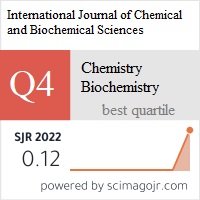International Journal of Chemical and Biochemical Sciences (ISSN 2226-9614)[/vc_column_text][/vc_column][/vc_row]
VOLUME 25(19) (2024)
Utilization of Pili (Canarium Ovatum) Sawdust in the Production of Bio-Crude Oil and Identification of its Potential Byproducts
Using Thermochemical Conversion
Jerico A. Prado*a, Florelyn D. Brillante b, Jean Claude B. Mendez c, Darrel M. Ocampo, Ph.D. d
a, b Duang Niog, Libmanan, Camarines Sur, Philippines, Central Bicol State University of Agriculture – Sipocot Campus
c Palangon, Libmanan, Camarines Sur, Philippines, Central Bicol State University of Agriculture -Sipocot Campus
d Tara, Sipocot, Camarines Sur, Philippines, Central Bicol State University of Agriculture – Sipocot Campus
Abstract
This study aimed to utilize Pili sawdust in the production of bio-crude oil and identify its potential by-products through thermochemical conversion. To obtain all the essential data, this research sought to answer the questions: (1) how much bio-crude oil can be produced at constant factors such as temperature and amount of Pili (Canarium ovatum) sawdust. (2) What are the physical characteristics of the generated bio-crude oil after conducting thermochemical conversion? (a) Color, (b) Appearance, and (c) Viscosity (3) What other potential by-product can be generated out of Pili (Canarium ovatum) sawdust after conducting thermochemical conversion. (4) What are the physical characteristics of the generated by-products after conducting thermochemical conversion? (a) Color and (b) Appearance. Experimental-descriptive method was used in perceiving the physical properties of the by-products and its bio-crude oil production, presented in milliliters (mL) and to be expressed in percentage respectively. Based on the gathered observation record results, data revealed that 1000 g of Pili sawdust in 340-oC temperature yields 30% or 300mL of brownish bio-crude oil in color, with a high degree of viscosity. Consequently, the generated by-products are biochar and synthesized biogas. The 242.2g of biochar, which yields 24.52%, resulted being porous and coarse-grained in texture. While the synthesized biogas generated 433.4g of net weight yields 43.34%, resulted in having a high flammability. For the betterment of similar study, future researchers are encouraged to evaluate the agricultural potential of the generated biochar and to distillate bio-crude oil for possible commercial use.
Keywords: Viscosity, distillate, thermochemical conversion, pyrolysis method and by product
Full length article – PDF *Corresponding Author, e-mail: jerico.prado@cbsua.edu.ph Doi # https://doi.org/10.62877/133-IJCBS-24-25-19-133
International Scientific Organization- Atom to Universe
Journals
- International Scientific Organization
- International Journal of Chemical and Biochemical Sciences (IJCBS)
- Volume 27 (2025)
- Volume 26 (2024)
- Volume 25 (2024)
- Volume 24 (2023)
- Volume 23 (2023)
- Volume 22 (2022)
- Volume 21 (2022)
- Volume 20 (2021)
- Volume 19 (2021)
- Volume 18 (2020)
- Volume 17 (2020)
- Volume 16 (2019)
- Volume 15 (2019)
- Volume 10 (2016)
- Volume 14 (2018)
- Volume 13 (2018)
- Volume 12 (2017)
- Volume 11 (2017)
- Volume 9 (2016)
- Volume 8 (2015)
- Volume 7 (2015)
- Volume 6 (2014)
- Volume 5 (2014)
- Volume 4 (2013)
- Volume 3 (2013)
- Volume 2 (2012)
- Volume 1 (2012)
- Store
- Cart
- Account


